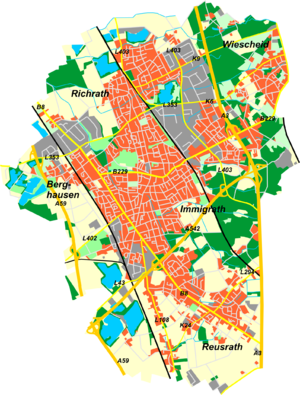House Graven
| House Graven | ||
|---|---|---|
|
Southeast corner of the moated castle |
||
| Creation time : | around 1300 | |
| Castle type : | Niederungsburg | |
| Conservation status: | essential parts received | |
| Construction: | Quarry stone | |
| Place: | Langenfeld - Wiescheid | |
| Geographical location | 51 ° 8 '13 " N , 6 ° 59' 10" E | |
| Height: | 75 m above sea level NN | |
|
|
||
Haus Graven is a moated castle in the Wiescheid district of Langenfeld and was probably built around 1300 as the successor castle to the former " Motte Schwanenmühle " located 800 meters to the north .
description
House Graven is a U-shaped quarry stone building , which is surrounded on three sides by wide moats . The current building is in the middle of the 17th century bailey , which has square towers with pyramid roofs protruding at their corners. The coat of arms of the Counts of Mirbach above the main portal , together with the year 1656, provides information about the construction date and the building owners. Nothing is left of the former manor house with its six towers. It is said to have been canceled in 1790.
history
The settlement name Graven was mentioned for the first time in 1334. The castle itself appears first documented in 1341, when Adolf Knappe of Graven from Cologne Archbishop Walram of Jülich with its fief was.
From the aforementioned von Graven , the castle later came to Rütger von Bottlenberg-Kessel through Johann von Overheid and his wife Agnes von Kessel through purchase in 1592 . His daughter Agnes von Bottlenberg-Kessel married a Gerhard von Aldenbrüggen called Velbrück in 1618 , who also owned Mauel (Windeck) an der Sieg and the Lanquit estate (today: Langfort ). It was his son Conrad Gumprecht von Velbrück (1624–1672) who had the facility repaired again in 1656 after being severely damaged by the Thirty Years' War . The latter also enjoys an outstanding position in the history of Langenfeld, as it was he who led Langenfeld from the Monheim office to independence on December 30, 1666 .
Through further marriage, Haus Graven came to the baron Johann Wilhelm Josef von Mirbach zu Harff in 1769 and was included in the list of goods eligible for parliament in 1832 . The Mirbach-Harff family remained the owners of the facility until 1974, before they sold it to a private individual who set up workrooms and studios in the outer bailey.
From 1994 to 1996 the castle was completely restored by private initiative - for use for residential purposes. When the owner died, the castle stood empty for a few years. At the end of 2010, the city of Langenfeld rented it for ten years to use it as a museum and event location. At the same time, the facility was to be made accessible to the public for the first time (including inside). The city of Langenfeld has transferred the operation of the system for the duration of the lease to the Förderverein Wasserburg Haus Graven eV and is currently subsidizing it with 50,000 euros annually. The opening of the castle to the general public took place on May 15, 2011.
literature
- Rolf Müller: City history Langenfeld. Langenfeld City Archives, Langenfeld 1992, ISBN 3-929365-01-4 .
- Claus-Peter Peters, Langenfeld through the ages , self-published, Langenfeld 2013, ISBN 978-3-00-035912-5
- Max Schmidt: Historical walks through Solingen city and country . Schwert-Verlag, Solingen 1922.
- Manfred Stuckmann: Verzällchen tour through Langenfeld. Life and people - yesterday and today. Langenfeld City Archives, Langenfeld 2004, ISBN 3-929365-17-0 .
Web links
Individual evidence
- ^ A b c Rolf Müller, " Stadtgeschichte Langenfeld Rheinland ", Verlag Stadtarchiv Langenfeld 1992
- ↑ a b Claus-Peter Peters, " Langenfeld im Wandel der Zeiten ", Langenfeld 2013
- ^ Friedhelm Görgens, " Langenfeld ", Verlag Droste 1984
- ^ A b Environmental Protection and Beautification Association Langenfeld eV, A guide through the built history of Langenfeld
- ↑ Stadtmagazin Langenfelder, June 2009, Graven House - a moated castle as a jewel for culture?

